
Motsunabe Recipe
Warm up with a bowl of rich and savory Motsunabe—a regional Japanese hot pot dish with plump beef offal, garlic chives, cabbage, and tofu simmered in a creamy miso broth. It's packed with deep umami goodness!
Ingredients
- 1 lb beef small intestine (defrosted if frozen; do not use pork offal—too smelly)
- 1 tsp Diamond Crystal kosher salt (for cleaning)
- 4 Tbsp all-purpose flour (plain flour) (for cleaning)
- 1 Tbsp sake (for parboiling)
For the Other Ingredients
- ½ head green cabbage (1.87 lb, 840 g with the core)
- 3 oz garlic chives (Chinese chives or Nira)
- ½ block medium-firm tofu (momen dofu) (7 oz, 200 g)
- 6 cloves garlic
- 2 pieces dried red chili pepper
- ½ lb sliced pork belly
- 6 oz bean sprouts
For the Hot Pot Broth
- 4 cups chicken stock/broth
- 3 Tbsp mirin
- 3 Tbsp soy sauce
- 2 Tbsp sake
- 1 Tbsp oyster sauce (you can use Lee Kum Kee vegetarian stir-fry sauce instead)
- 2 Tbsp toasted white sesame seeds (set aside 1 tsp for garnish)
- 2 Tbsp miso (any type)
For Serving
- yuzu kosho (Japanese citrus chili paste) (optional)
Instructions
- Gather all the ingredients. My recipe portion is for a family-size donabe, and I'm using my favorite Ginpo Kikka family-size donabe (it also comes in an induction-compatible version).
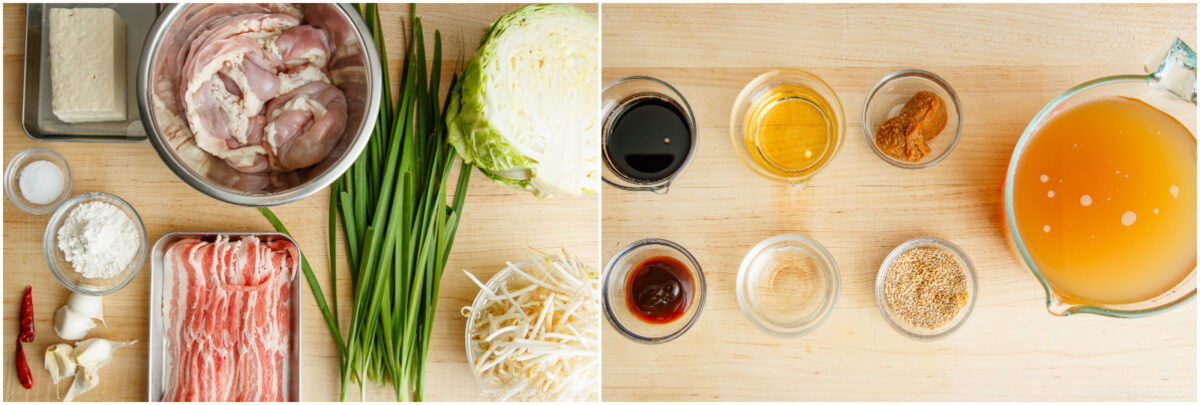
To Prepare the Ingredients
- Using a sharp knife, cut out the thick core from ½ head green cabbage. Chop the cabbage into squares about 1–1½ inches (2.5–3.8 cm), then wash and dry it.
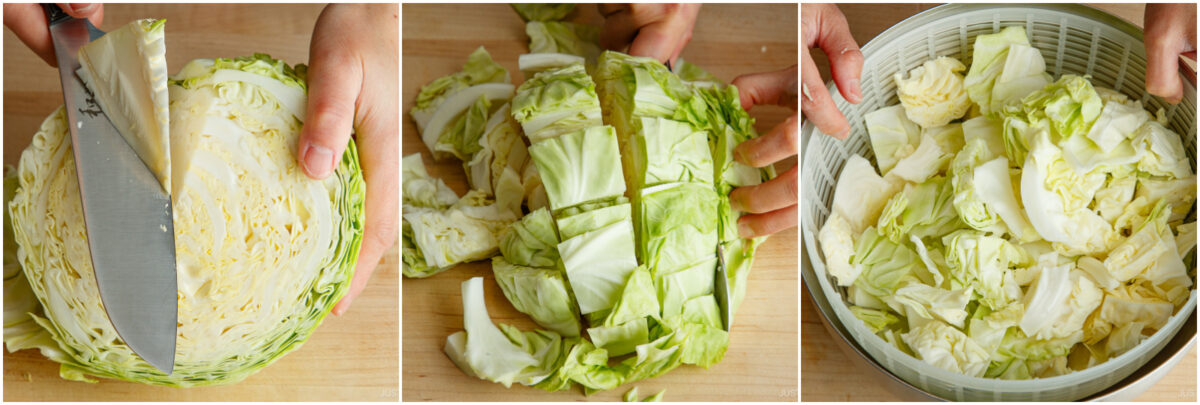
- Cut off the tough ends of 3 oz garlic chives (Chinese chives or Nira) and slice it into 2-inch (5-cm) pieces. Next, slice ½ block medium-firm tofu (momen dofu) into thin slabs.
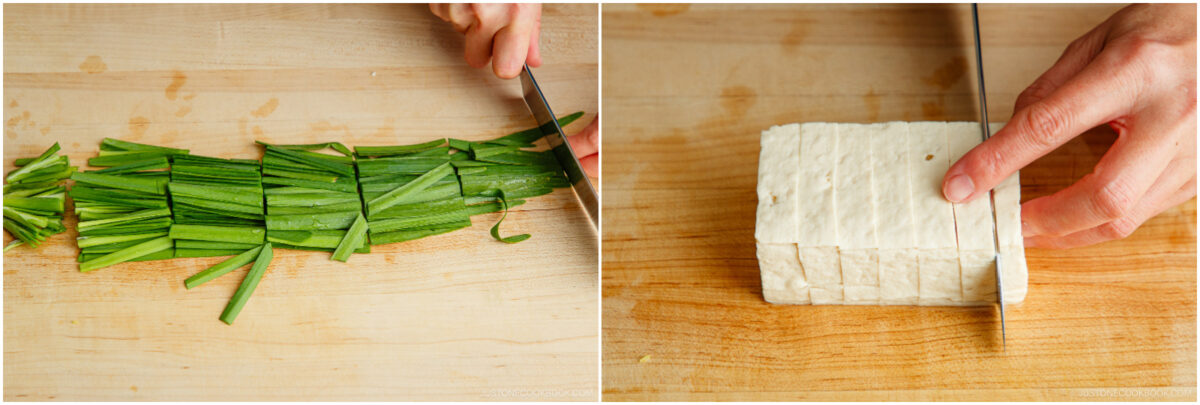
- Thinly slice 6 cloves garlic crosswise. Cut 2 pieces dried red chili pepper into thin rounds, discarding the seeds if you prefer a less spicy hot pot.
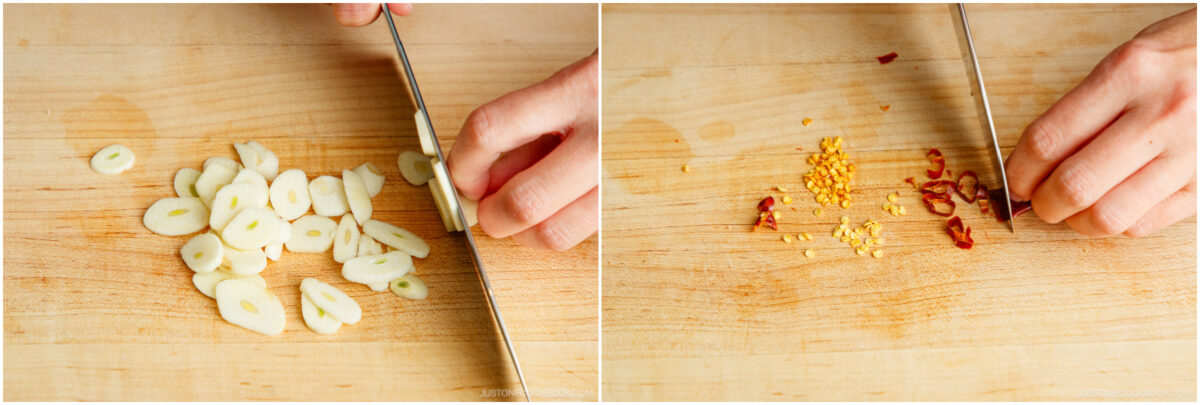
- Cut ½ lb sliced pork belly into 2-inch (5-cm) pieces.

To Clean and Parboil the Offal
- Using a pair of kitchen shears, cut 1 lb beef small intestine into 1-foot (30-cm) tubes.

- Initial rinse: Clean the inside of each tube with running water while rubbing it from the outside. Straighten the intestine so water flows smoothly and you can clean inside the tubes. Take your time.
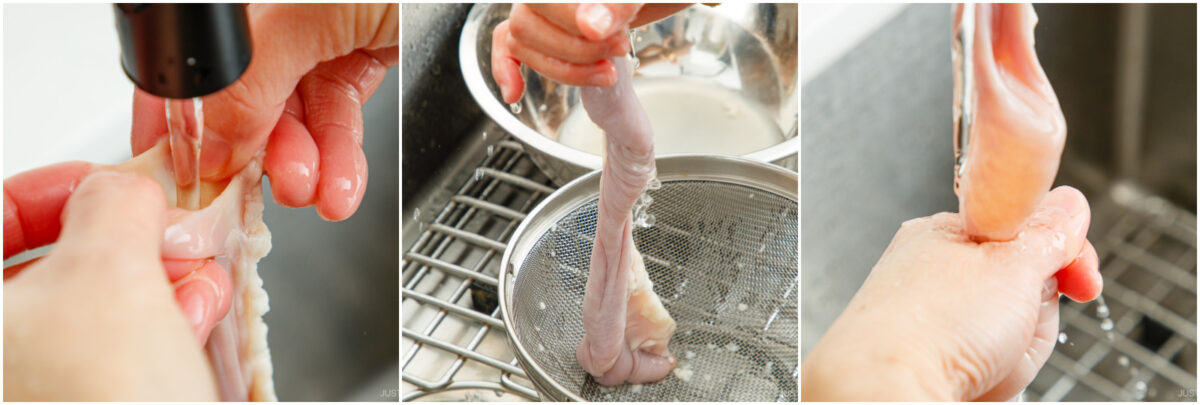
- Cut the tubes into smaller pieces no more than 1 inch (2.5 cm) long. Place them in a large bowl.

- Rub with salt: Sprinkle with 1 tsp Diamond Crystal kosher salt and rub it into the intestine pieces with your hand.
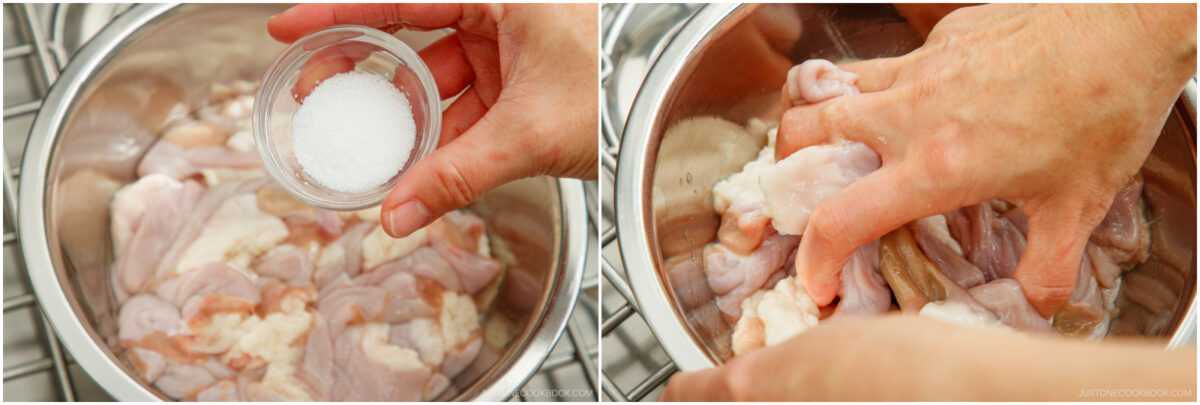
- Massage well with the salt to absorb odors and help remove slime. Rinse it again, using the force of the running water to thoroughly wash away any remaining dirt or odors from the offal. Drain.
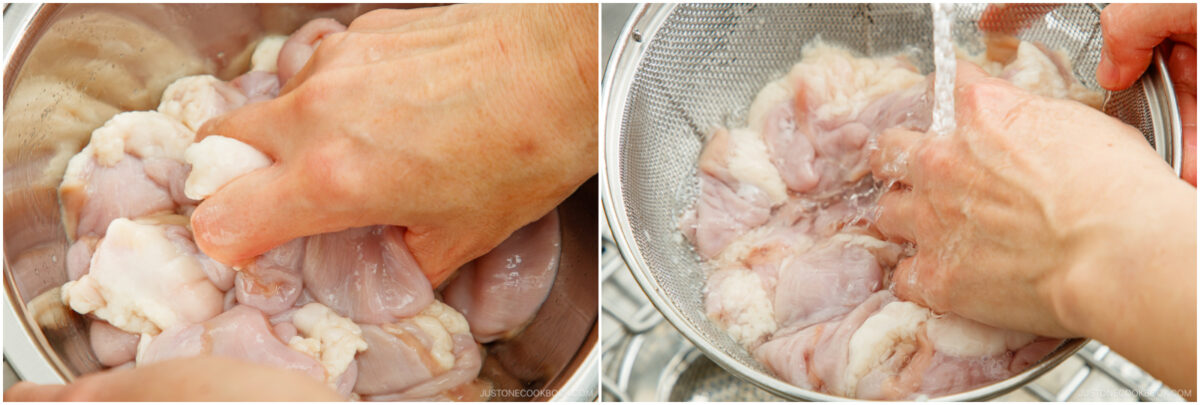
- Rub with flour: Now, generously coat the intestine pieces with 4 Tbsp all-purpose flour (plain flour) Rub it in thoroughly with your hand.
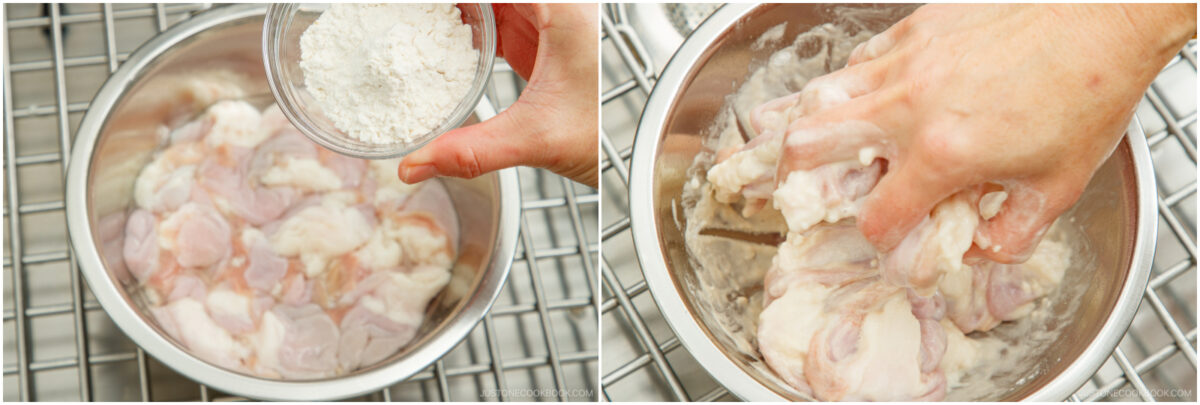
- Wash off the flour and impurities with water and drain in a sieve.

- Final rinse: Clean the pieces one by one in running water. Take your time to wash them thoroughly, then place in a clean bowl. Tip: Read the Notes for how to clean the kitchen sink after handling offal.

- Parboil: Bring 4 cups (1L) of water to a boil in a medium saucepan. Once boiling, add 1 Tbsp sake. Then, add the intestine pieces.

- Blanch the offal for 1 minute. Transfer to a plate or tray and set it aside. Tip: Parboil it only briefly to remove excess oil; do allow the fat to render. This fat is essential for a delicious creamy and savory broth, so we want to cook it in the main hot pot.

To Mix the Hot Pot Broth
- Grind 2 Tbsp toasted white sesame seeds in a mortar and pestle. Leave some seeds unground for texture.

- Combine 4 cups chicken stock/broth, 3 Tbsp mirin, 2 Tbsp sake, 3 Tbsp soy sauce, and 1 Tbsp oyster sauce in a measuring cup or bowl.

- Add the ground sesame seeds and stir to combine.
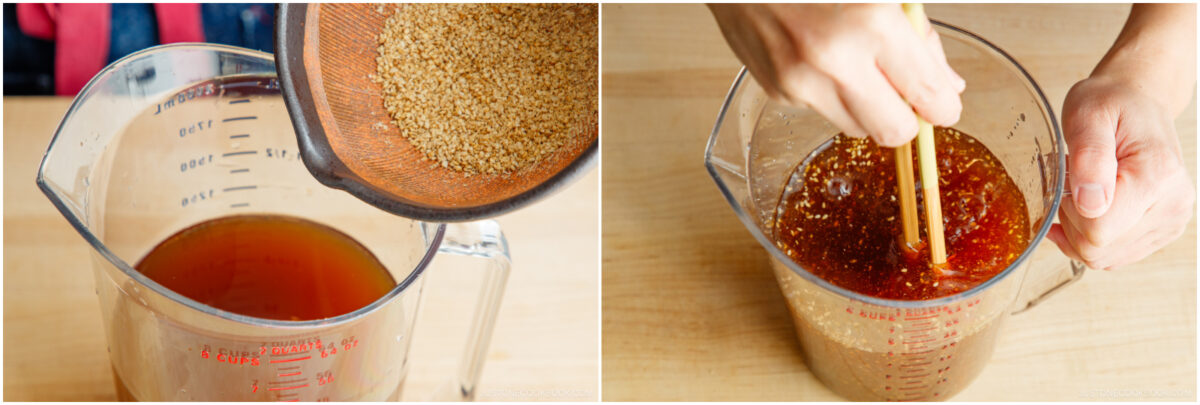
To Cook the Motsunabe
- Add the broth ingredients to a donabe or heavy-bottomed pot. Bring it to a simmer over medium heat.

- Dissolve 2 Tbsp miso into the hot broth. I'm using my favorite miso muddler and draining ladle.

- Add all of the cabbage and 6 oz bean sprouts. Cover the pot and bring to a simmer. Tip: Don't worry, it may look like a lot at first, but they will eventually wilt.
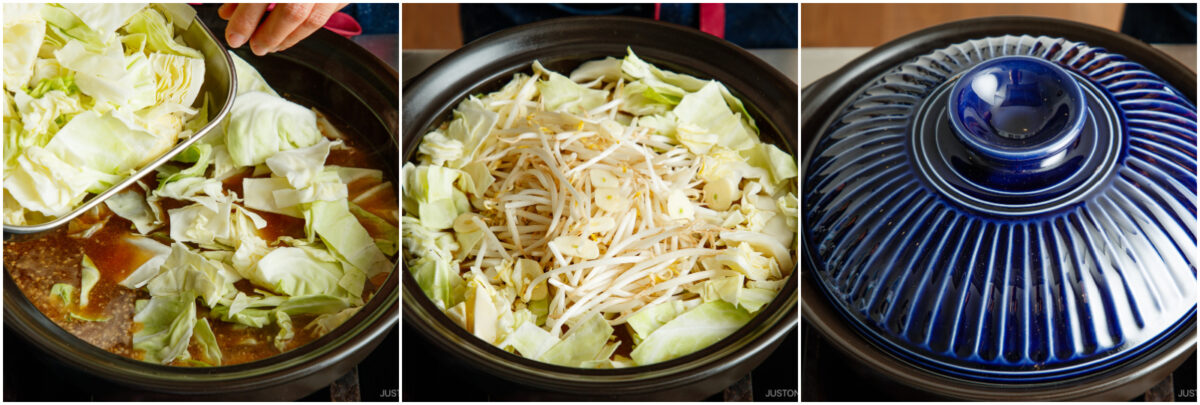
- Once simmering, add the pork belly on one side and the intestine on the other side, keeping the middle open. Place the tofu on one end. Finally, place the garlic cloves, garlic chives, chili pieces, and sesame seeds garnish across the middle. Cover and cook for 10–15 minutes. When it reaches a boil, reduce the heat to medium low and continue to simmer.
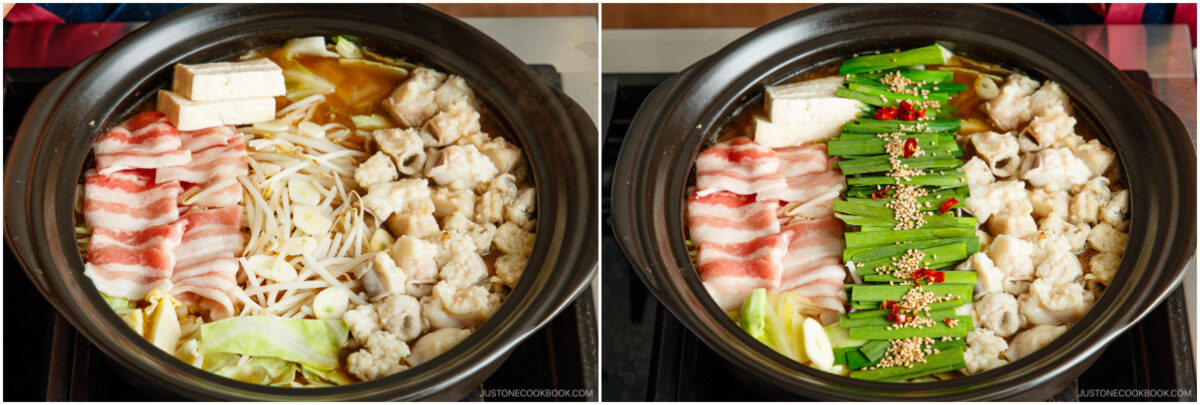
To Serve
- When the cabbage is tender and the pork is cooked through, serve and enjoy it with optional yuzu kosho (Japanese citrus chili paste).
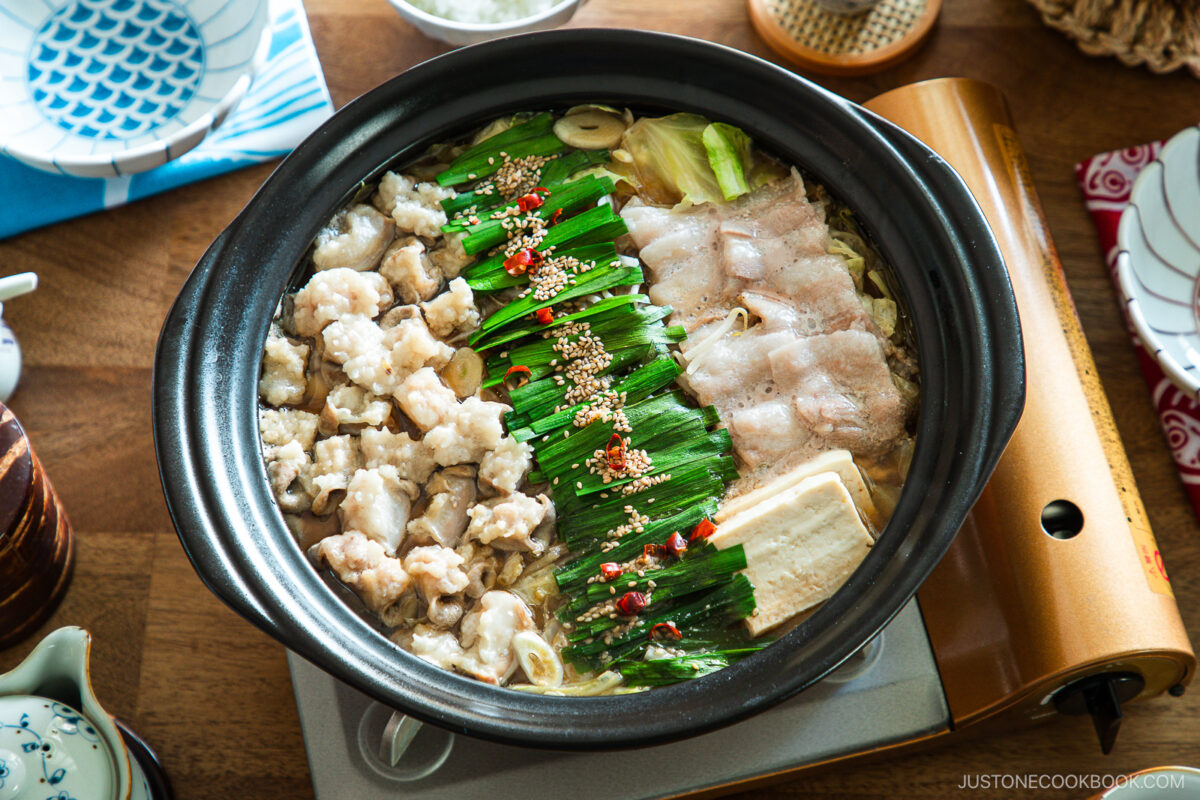
- Finishing course (optional): After you've finished the main course, you can use the rich and creamy broth to make rice porridge or ramen noodles to end the meal.
To Store
- Transfer the leftovers in an airtight container and keep in the refrigerator for 3 days or in the freezer for up to a month. Remove the tofu before freezing as its texture will change when frozen. Reheat in a pot on the stove over medium heat. If you previously froze it, defrost it in the refrigerator overnight and add fresh tofu when reheating.
Notes
Cleaning the kitchen sink after handling offal is important to remove any lingering odors and bacteria. Here are som effective steps that will ensure your sink is odor-free, grease-free, and sanitized after handling offal.
1. Rinse Thoroughly
- Use hot running water to wash away any visible residue immediately after cleaning the offal.
- Pay extra attention to the drain area, where bits of fat or slime may accumulate.
- Sprinkle baking soda over the sink and scrub with a sponge or brush.
- Add a bit of dish soap to cut through grease and remove odors.
- Spray white vinegar around the sink and let it sit for a few minutes before rinsing. It helps neutralize odors and kill bacteria.
- To deep clean, mix a bleach solution of 1 part bleach with 10 parts water. Then pour it around the sink, let it sit for 5–10 minutes, and rinse well.
- Pour ½ cup baking soda into the drain followed by ½ cup hot vinegar. Let it fizz for a few minutes, then flush with hot water.
- Alternatively, pour boiling water down the drain to dissolve grease buildup.
- Rub a cut lemon over the sink or add a few drops of tea tree or eucalyptus oil for a fresh, clean scent.
Nutrition
Calories: 805kcal, Carbohydrates: 24g, Protein: 29g, Fat: 65g, Saturated Fat: 26g, Polyunsaturated Fat: 6g, Monounsaturated Fat: 28g, Cholesterol: 279mg, Sodium: 965mg, Potassium: 854mg, Fiber: 9g, Sugar: 13g, Vitamin A: 1241IU, Vitamin C: 114mg, Calcium: 259mg, Iron: 5mg